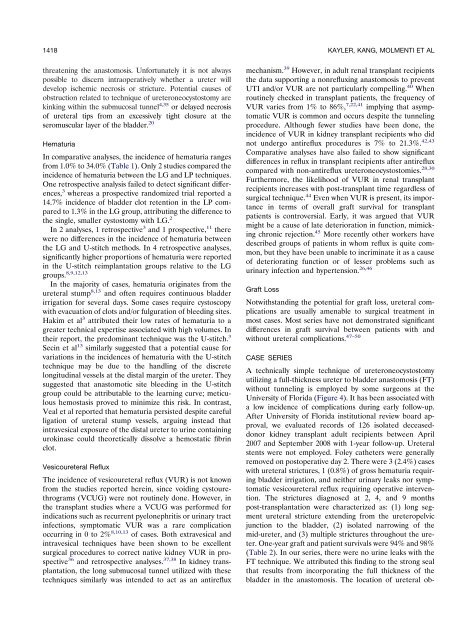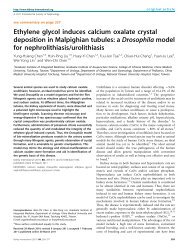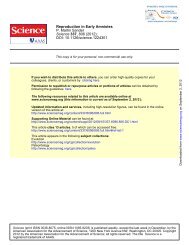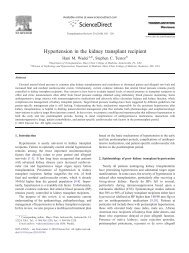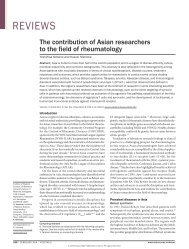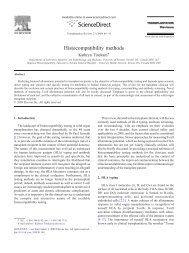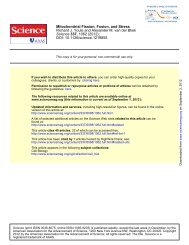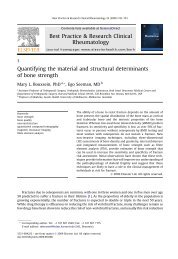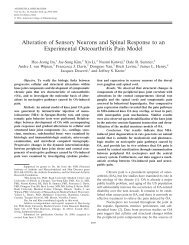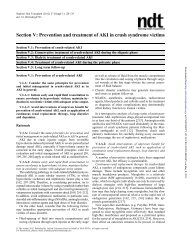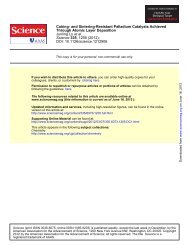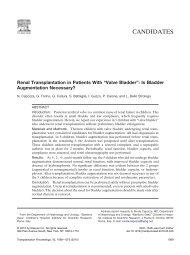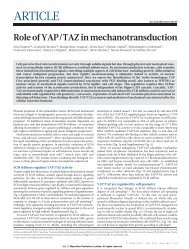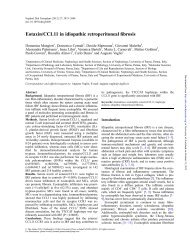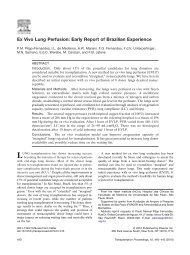Kidney Transplant Ureteroneocystostomy Techniques and ...
Kidney Transplant Ureteroneocystostomy Techniques and ...
Kidney Transplant Ureteroneocystostomy Techniques and ...
You also want an ePaper? Increase the reach of your titles
YUMPU automatically turns print PDFs into web optimized ePapers that Google loves.
1418 KAYLER, KANG, MOLMENTI ET AL<br />
threatening the anastomosis. Unfortunately it is not always<br />
possible to discern intraoperatively whether a ureter will<br />
develop ischemic necrosis or stricture. Potential causes of<br />
obstruction related to technique of ureteroneocystostomy are<br />
kinking within the submucosal tunnel 4,35 or delayed necrosis<br />
of ureteral tips from an excessively tight closure at the<br />
seromuscular layer of the bladder. 20<br />
Hematuria<br />
In comparative analyses, the incidence of hematuria ranges<br />
from 1.0% to 34.0% (Table 1). Only 2 studies compared the<br />
incidence of hematuria between the LG <strong>and</strong> LP techniques.<br />
One retrospective analysis failed to detect significant differences,<br />
3 whereas a prospective r<strong>and</strong>omized trial reported a<br />
14.7% incidence of bladder clot retention in the LP compared<br />
to 1.3% in the LG group, attributing the difference to<br />
the single, smaller cystostomy with LG. 2<br />
In 2 analyses, 1 retrospective 3 <strong>and</strong> 1 prospective, 11 there<br />
were no differences in the incidence of hematuria between<br />
the LG <strong>and</strong> U-stitch methods. In 4 retrospective analyses,<br />
significantly higher proportions of hematuria were reported<br />
in the U-stitch reimplantation groups relative to the LG<br />
groups. 8,9,12,13<br />
In the majority of cases, hematuria originates from the<br />
ureteral stump 8,13 <strong>and</strong> often requires continuous bladder<br />
irrigation for several days. Some cases require cystoscopy<br />
with evacuation of clots <strong>and</strong>/or fulguration of bleeding sites.<br />
Hakim et al 3 attributed their low rates of hematuria to a<br />
greater technical expertise associated with high volumes. In<br />
their report, the predominant technique was the U-stitch. 3<br />
Secin et al 13 similarly suggested that a potential cause for<br />
variations in the incidences of hematuria with the U-stitch<br />
technique may be due to the h<strong>and</strong>ling of the discrete<br />
longitudinal vessels at the distal margin of the ureter. They<br />
suggested that anastomotic site bleeding in the U-stitch<br />
group could be attributable to the learning curve; meticulous<br />
hemostasis proved to minimize this risk. In contrast,<br />
Veal et al reported that hematuria persisted despite careful<br />
ligation of ureteral stump vessels, arguing instead that<br />
intravesical exposure of the distal ureter to urine containing<br />
urokinase could theoretically dissolve a hemostatic fibrin<br />
clot.<br />
Vesicoureteral Reflux<br />
The incidence of vesicoureteral reflux (VUR) is not known<br />
from the studies reported herein, since voiding cystourethrograms<br />
(VCUG) were not routinely done. However, in<br />
the transplant studies where a VCUG was performed for<br />
indications such as recurrent pyelonephritis or urinary tract<br />
infections, symptomatic VUR was a rare complication<br />
occurring in 0 to 2% 8,10,13 of cases. Both extravesical <strong>and</strong><br />
intravesical techniques have been shown to be excellent<br />
surgical procedures to correct native kidney VUR in prospective<br />
36 <strong>and</strong> retrospective analyses. 37,38 In kidney transplantation,<br />
the long submucosal tunnel utilized with these<br />
techniques similarly was intended to act as an antireflux<br />
mechanism. 39 However, in adult renal transplant recipients<br />
the data supporting a nonrefluxing anastomosis to prevent<br />
UTI <strong>and</strong>/or VUR are not particularly compelling. 40 When<br />
routinely checked in transplant patients, the frequency of<br />
VUR varies from 1% to 86%, 7,22,41 implying that asymptomatic<br />
VUR is common <strong>and</strong> occurs despite the tunneling<br />
procedure. Although fewer studies have been done, the<br />
incidence of VUR in kidney transplant recipients who did<br />
not undergo antireflux procedures is 7% to 21.3%. 42,43<br />
Comparative analyses have also failed to show significant<br />
differences in reflux in transplant recipients after antireflux<br />
compared with non-antireflux ureteroneocystostomies. 28,30<br />
Furthermore, the likelihood of VUR in renal transplant<br />
recipients increases with post-transplant time regardless of<br />
surgical technique. 44 Even when VUR is present, its importance<br />
in terms of overall graft survival for transplant<br />
patients is controversial. Early, it was argued that VUR<br />
might be a cause of late deterioration in function, mimicking<br />
chronic rejection. 45 More recently other workers have<br />
described groups of patients in whom reflux is quite common,<br />
but they have been unable to incriminate it as a cause<br />
of deteriorating function or of lesser problems such as<br />
urinary infection <strong>and</strong> hypertension. 26,46<br />
Graft Loss<br />
Notwithst<strong>and</strong>ing the potential for graft loss, ureteral complications<br />
are usually amenable to surgical treatment in<br />
most cases. Most series have not demonstrated significant<br />
differences in graft survival between patients with <strong>and</strong><br />
without ureteral complications. 47–50<br />
CASE SERIES<br />
A technically simple technique of ureteroneocystostomy<br />
utilizing a full-thickness ureter to bladder anastomosis (FT)<br />
without tunneling is employed by some surgeons at the<br />
University of Florida (Figure 4). It has been associated with<br />
a low incidence of complications during early follow-up.<br />
After University of Florida institutional review board approval,<br />
we evaluated records of 126 isolated deceaseddonor<br />
kidney transplant adult recipients between April<br />
2007 <strong>and</strong> September 2008 with 1-year follow-up. Ureteral<br />
stents were not employed. Foley catheters were generally<br />
removed on postoperative day 2. There were 3 (2.4%) cases<br />
with ureteral strictures, 1 (0.8%) of gross hematuria requiring<br />
bladder irrigation, <strong>and</strong> neither urinary leaks nor symptomatic<br />
vesicoureteral reflux requiring operative intervention.<br />
The strictures diagnosed at 2, 4, <strong>and</strong> 9 months<br />
post-transplantation were characterized as: (1) long segment<br />
ureteral stricture extending from the ureteropelvic<br />
junction to the bladder, (2) isolated narrowing of the<br />
mid-ureter, <strong>and</strong> (3) multiple strictures throughout the ureter.<br />
One-year graft <strong>and</strong> patient survivals were 94% <strong>and</strong> 98%<br />
(Table 2). In our series, there were no urine leaks with the<br />
FT technique. We attributed this finding to the strong seal<br />
that results from incorporating the full thickness of the<br />
bladder in the anastomosis. The location of ureteral ob-


